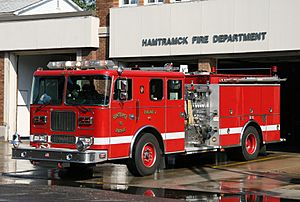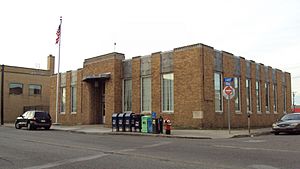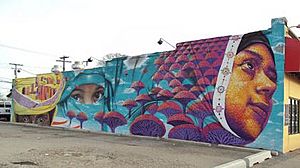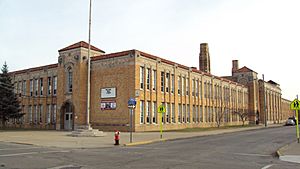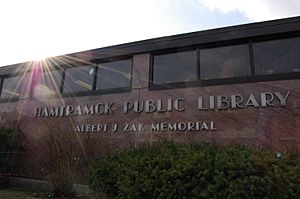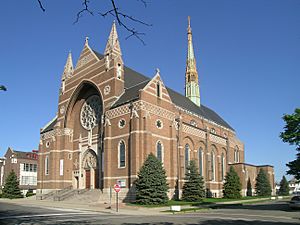Hamtramck, Michigan facts for kids
Quick facts for kids
Hamtramck, Michigan
|
|||
|---|---|---|---|

Downtown Hamtramck in 2012
|
|||
|
|||
| Nickname(s):
The World in Two Square Miles, Hamtown
|
|||

Location of Hamtramck in Wayne County, Michigan
|
|||
| Country | United States | ||
| State | Michigan | ||
| County | Wayne | ||
| Organized | 1798 | ||
| Incorporated (town) | 1901 | ||
| Incorporated (city) | 1922 | ||
| Government | |||
| • Type | Mayor–council | ||
| Area | |||
| • Total | 2.090 sq mi (5.413 km2) | ||
| • Land | 2.090 sq mi (5.413 km2) | ||
| • Water | 0.000 sq mi (0.000 km2) | ||
| Elevation | 630 ft (192 m) | ||
| Population
(2020)
|
|||
| • Total | 28,433 | ||
| • Estimate
(2023)
|
27,339 | ||
| • Density | 13,080/sq mi (5,051/km2) | ||
| Time zone | UTC−5 (Eastern (EST)) | ||
| • Summer (DST) | UTC−4 (EDT) | ||
| ZIP Codes |
48211, 48212
|
||
| Area code(s) | 313 | ||
| FIPS code | 26-36280 | ||
| GNIS feature ID | 0627707 | ||
| Sales tax | 6.0% | ||
Hamtramck (pronounced ham-TRAM-ik) is a city in Michigan, located in Wayne County. It's like a small island within the larger city of Detroit, about 5 miles (8 km) north of downtown Detroit.
In 2020, Hamtramck had a population of 28,433 people. This makes it the most crowded city in Michigan. Hamtramck is special because it's the only city in the United States where most of the people are Muslim.
For a long time in the 1900s, Hamtramck was known for its large Polish-American community. But in the 2000s, many new immigrants moved there. These new residents came from countries like Yemen, Bangladesh, and Pakistan. In 2013, Hamtramck became the first U.S. city with a majority Muslim population. By 2015, it was also the first city to have a city council where most members were Muslim. In 2021, the city elected an all-Muslim city council and mayor, a first for any U.S. city.
Contents
What's in a Name?
Hamtramck is named after Jean-François Hamtramck. He was a French-Canadian soldier. He was also the first American commander of Fort Shelby in Detroit. The area was first called Hamtramck Township.
A Look at Hamtramck's Past
Hamtramck was first settled by German farmers. But when the Dodge Brothers car plant opened in 1914, many Polish immigrants moved to the area. For many years, Polish people made up most of the population. In 1970, about 90% of the people were Polish. By 2010, this number was about 14.5%.
In the 1920s and 1930s, some places in Hamtramck openly operated as bars. This was during a time called Prohibition, when selling certain drinks was not allowed.
Over the last 30 years, many immigrants have moved to Hamtramck. They came from the Middle East (especially Yemen), India, Pakistan, Bangladesh, Nepal, and southeastern Europe (like Albania, Bosnia and Herzegovina, and Kosovo). In 2010, over 41% of Hamtramck's population was born outside the U.S. This makes it Michigan's most diverse city.
Hamtramck used to be mostly farmland. In 1901, part of the area became a village. This helped the community manage its own affairs. By 1922, it became a city to stop Detroit from taking over its land. By the mid-1920s, many residents owned their homes. About 85% of households had factory workers. The Dodge Main assembly plant, which opened in 1910, brought many jobs and money to Hamtramck. This plant led to a large number of Polish immigrants moving in.
Later, the Dodge Main plant closed. Also, parts of the Polish neighborhoods were changed. This led to a big shift in who lived in Hamtramck. More people from the Middle East, India, Pakistan, Bangladesh, and Nepal moved in. By 2015, the city was believed to be the first to elect a city council with a Muslim majority. In November 2021, Hamtramck made history again. It elected an all-Muslim city council and a Muslim mayor. This was the first time a U.S. city was fully governed by Muslim-Americans.
Where is Hamtramck?
Hamtramck is a small city, covering about 2.09 square miles (5.41 square kilometers) of land. It's mostly surrounded by Detroit. Only a small part of its border touches Highland Park, which is also mostly surrounded by Detroit.
The I-75 freeway runs along Hamtramck's western side. The I-94 freeway is near its southern border. Hamtramck is known for being easy to walk around. This is helpful for new immigrants who might not have a car yet.
Hamtramck's Culture and Community
Hamtramck grew a lot between 1910 and 1920. Thousands of immigrants from Europe, especially Poland, came for jobs in the car industry. Today, the city is very diverse. But you can still see its Polish roots in family names, street names, and businesses. In 2018, a survey found that students in Hamtramck schools spoke 16 different native languages! A common saying about the city is "A League of Nations."
The Hamtramck Historical Museum and the Polish Art Center are next to each other. They help preserve the city's history and Polish heritage.
In 1997, a magazine called Utne Reader named Hamtramck one of the "hippest neighborhoods" in the U.S. and Canada. This was because of its music scene, a Buddhist temple, its many cultures, and its friendly neighborhoods.
In 2004, an Islamic center asked to use loudspeakers for the call to prayer. This caused a big discussion in the city. In the end, Hamtramck changed its noise rules to allow the prayer calls.
Hamtramck Disneyland is a unique art display in the city. It's built on two garages using metal.
Fun Festivals in Hamtramck
Pączki Day
Polish immigrants and residents celebrate Tłusty Wtorek (Fat Tuesday), also known as Pączki Day. People line up at Polish bakeries to buy pączki, which are like delicious donuts. Many local bars also have parties with music and free pączki.
Hamtramck Music Festival
This is an annual independent music festival held in March. Many bands play at different venues across the city.
St. Florian Strawberry Festival
This festival happens every year on the first weekend of May. It's held at the grounds of St. Florian Church.
Hamtramck Labor Day Festival
This festival takes place on Labor Day weekend. It ends with the Polish Day Parade on Labor Day. The festival has live music, carnival rides, and food. It stretches along Joseph Campau Street.
What Hamtramck Makes and Does
General Motors has a large car plant called Detroit/Hamtramck Assembly on the border of Hamtramck and Detroit. This plant used to make cars like the Chevrolet Volt and Cadillac CT6. It closed in 2019 and was rebuilt to make electric vehicles like the GMC Hummer EV.
The Polish Art Center is an important place in Hamtramck. It helps keep Polish heritage alive by showing cultural items. It also hosts talks, workshops, and art classes.
The Ukrainian American Archives & Museum of Detroit is also in Hamtramck. It teaches people about Ukrainian culture, art, and history. It also shares stories of Ukrainians who came to America.
Kowalski Sausage Co. has been making meat products in Hamtramck for over 85 years. Their products are sold around the Detroit area.
In 2010, Hamtramck faced money problems and asked the state of Michigan for permission to declare bankruptcy. This request was denied. The city avoided bankruptcy by making a deal with Detroit about shared taxes and water bills.
The United States Postal Service has a post office in Hamtramck on Caniff Street.
Sports in Hamtramck
Hamtramck is home to Detroit City FC (DCFC). This is a professional American soccer club. They play their home games at Keyworth Stadium.
A Little League team from Hamtramck won the 1959 Little League World Series. They were the first team from Michigan to win this title.
Who Lives in Hamtramck?
| Historical population | |||
|---|---|---|---|
| Census | Pop. | %± | |
| 1910 | 3,559 | — | |
| 1920 | 48,615 | 1,266.0% | |
| 1930 | 56,268 | 15.7% | |
| 1940 | 49,839 | −11.4% | |
| 1950 | 43,555 | −12.6% | |
| 1960 | 34,137 | −21.6% | |
| 1970 | 26,783 | −21.5% | |
| 1980 | 21,300 | −20.5% | |
| 1990 | 18,372 | −13.7% | |
| 2000 | 22,976 | 25.1% | |
| 2010 | 22,423 | −2.4% | |
| 2020 | 28,433 | 26.8% | |
| 2023 (est.) | 27,339 | 21.9% | |
| U.S. Decennial Census 2020 Census |
|||
Hamtramck is known for its diverse population. In 2020, there were 28,433 people living in the city. The population is made up of many different groups. About 55.9% were White (including people from the Middle East and North Africa). About 10% were African American, and 26.9% were Asian. People of Hispanic or Latino background made up about 1.1% of the population.
The city has a young population. About 32.6% of residents were under 18 years old.
Different Cultures in Hamtramck
Hamtramck has always been a place for immigrants. In the 1900s, many people from Eastern Europe moved there. Later, people from Albania, Bosnia, Macedonia, Ukraine, and Yemen arrived. By 2001, many Bangladeshis, Bosnians, and Iraqi Chaldeans were also moving to Hamtramck.
Today, over 30 languages are spoken in Hamtramck. More than four religions are practiced, including Islam, Christianity, Hinduism, and Buddhism. In 2013, the city put up flags from 18 countries. These flags represent the home countries of Hamtramck residents.
Bangladeshi Community
The first Bengalis came to Hamtramck in the 1930s. A larger group started arriving in the late 1980s and 1990s. Many Bangladeshi Americans moved from New York City to Hamtramck. They came for lower living costs, more space, factory jobs, and the large Muslim community in the area.
By 2002, most of Michigan's Bangladeshi population lived in Hamtramck. A Bengali business area formed along Conant Avenue, sometimes called "Little Bengal." This area has markets, stores, and mosques owned by Bangladeshis, Indians, and Pakistanis. In 2008, this area was officially named "Bangladesh Avenue."
Yemeni Community
Most of the Middle Eastern population in Hamtramck is Yemeni. There are many Yemeni restaurants in the city. The Yemeni community also runs the Mu'ath bin Jabal Mosque. This mosque was built in 1976 and is one of the largest in the area.
In 2013, a Chilean artist created a large mural on the Sheeba restaurant. This mural celebrates the Yemeni population. It shows a girl in a veil, a farmer, and a woman in a hijab.
Learning in Hamtramck
Public Schools
Hamtramck Public Schools serves the city. Hamtramck High School is the main public high school. There are also several charter schools in Hamtramck. These include Hanley International Academy, Frontier International Academy, Hamtramck Academy, Bridge Academy, Caniff Liberty Academy, and Oakland International Academy.
Private Schools
Hamtramck used to have many Catholic schools. These included St. Florian Elementary School, Our Lady Queen of Apostles, and St. Ladislaus Elementary School. There was also St. Florian High School. In the 1920s, Catholic schools in Hamtramck often had many students in each classroom.
Over time, some of these schools closed or merged. By 2005, there were no Catholic schools left within Hamtramck city limits.
School History
In the 1920s, many Hamtramck families sent their children to public school for kindergarten. Then, they would move them to Catholic schools for important religious lessons. After that, many students would return to public school.
During the 1920s, many students in Hamtramck left school early. A survey in 1924-1925 showed that many male students who left school started working in factories.
Public Libraries
The Hamtramck Public Library Albert J. Zak Memorial is located on Caniff Street. It was first started in 1918. The current library building was completed in 1956.
Hamtramck Through the Years
- 1796: Colonel Jean-François Hamtramck took control of Detroit.
- 1798: The Township of Hamtramck was created.
- 1901: Hamtramck became a village.
- 1908: Saint Florian Roman Catholic Church was the first Catholic church in Hamtramck.
- 1910: The Dodge Brothers Motor Car Company started building a car plant in Hamtramck. Many European immigrants began to arrive.
- 1914: The Dodge Brothers plant opened.
- 1922: Hamtramck became a city to avoid being taken over by Detroit. Peter C. Jezewski was the first mayor.
- 1959: A Little League team from Hamtramck won the 1959 Little League World Series.
- 2000: Hamtramck faced financial problems.
- 2013: Hamtramck became the first U.S. city with a Muslim-majority population.
- 2015: Hamtramck became the first U.S. city to elect a city council with a Muslim majority.
- 2022: Hamtramck became the first U.S. city with an all-Muslim government.
Between 1910 and 1920, Hamtramck's population grew by a huge amount, over 1,200 percent!
Famous People from Hamtramck
- Jane Bartkowicz, a tennis player.
- Danny Brown, a rapper.
- Amer Ghalib, the current mayor of Hamtramck.
- John Hodiak, an actor.
- Gail Kobe, an actress.
- Mitch Ryder, a singer.
- Rudy Tomjanovich, a professional basketball player and coach.
See also
 In Spanish: Hamtramck (Míchigan) para niños
In Spanish: Hamtramck (Míchigan) para niños




